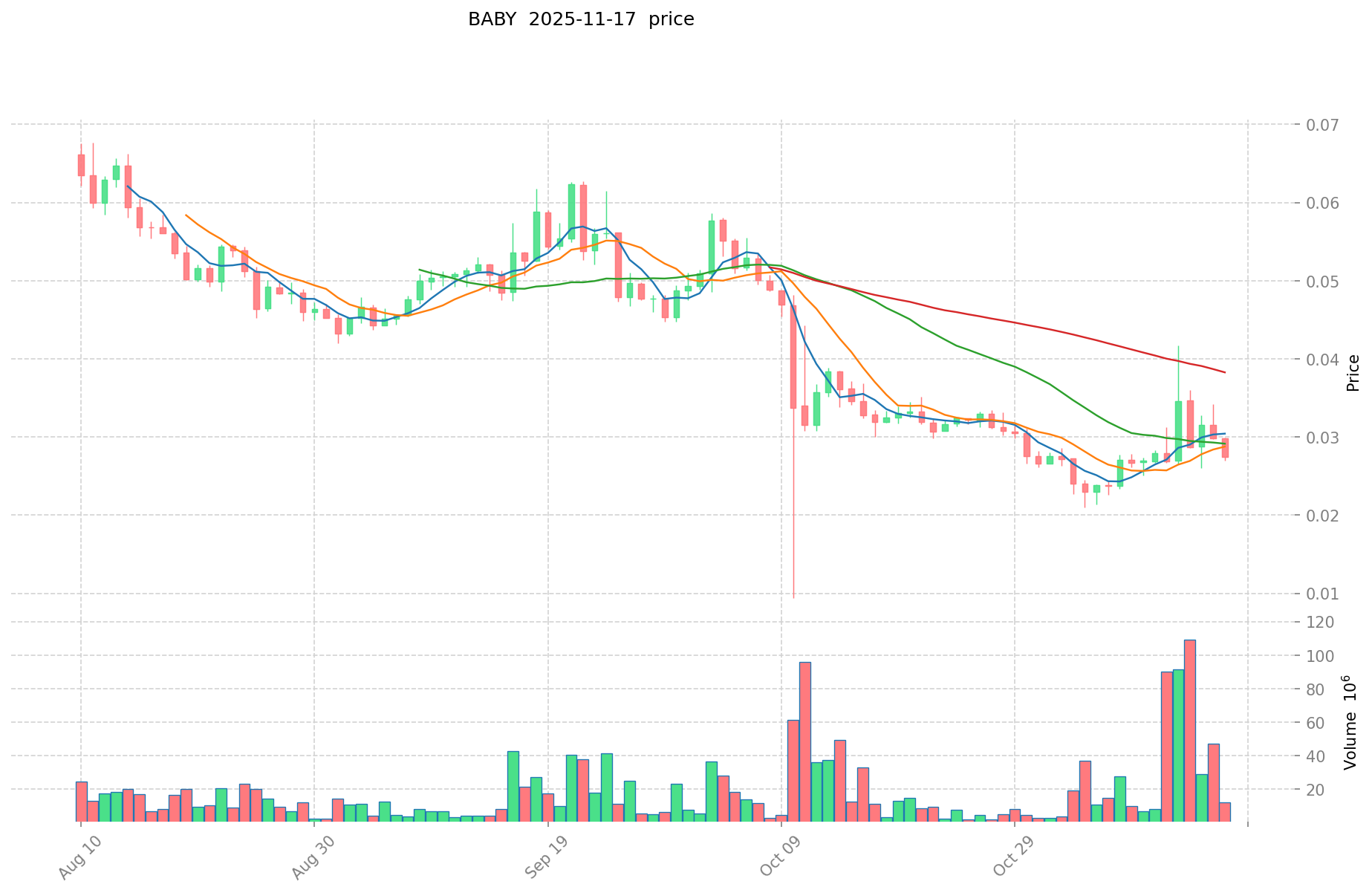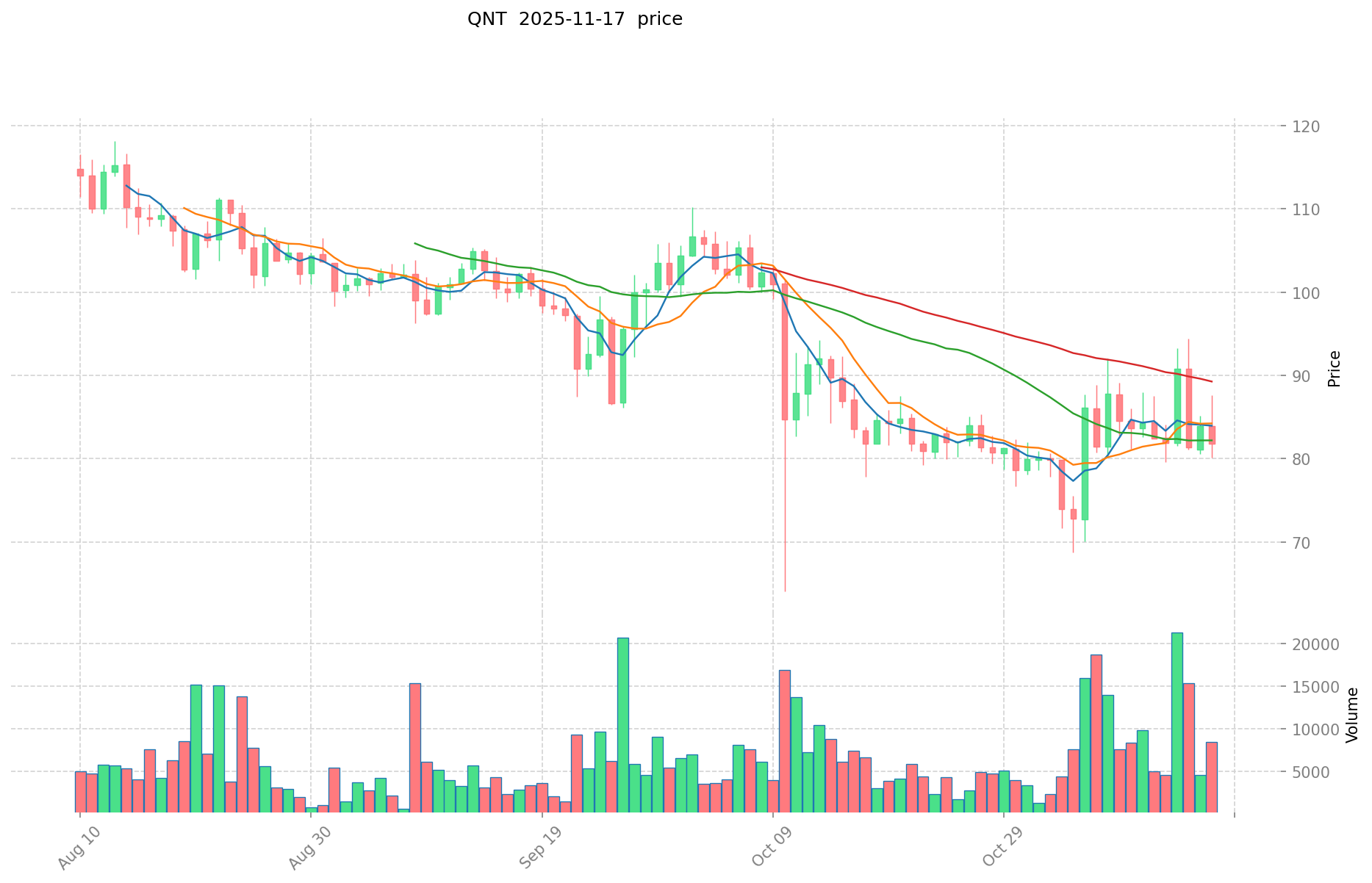BABY vs QNT: The Battle of Blockchain Titans in the Decentralized Finance Arena
Introduction: BABY vs QNT Investment Comparison
In the cryptocurrency market, the comparison between Babylon (BABY) and Quant (QNT) remains a crucial topic for investors. These two assets not only differ significantly in market cap ranking, use cases, and price performance but also represent distinct positions in the crypto asset landscape.
Babylon (BABY): Launched in 2025, it has gained market recognition for its innovative approach to native Bitcoin staking on the Bitcoin blockchain.
Quant (QNT): Since its introduction in 2018, it has been hailed as a solution for blockchain interoperability, positioning itself as a leader in enterprise innovation and blockchain adoption.
This article will comprehensively analyze the investment value comparison between BABY and QNT, focusing on historical price trends, supply mechanisms, institutional adoption, technological ecosystems, and future projections, attempting to answer the question most critical to investors:
"Which is the better buy right now?"
I. Price History Comparison and Current Market Status
BABY (Coin A) and QNT (Coin B) Historical Price Trends
- 2025: BABY reached its all-time high of $0.17201 on April 10, and its all-time low of $0.00935 on October 10.
- 2021: QNT hit its all-time high of $427.42 on September 11.
- Comparative analysis: In the recent market cycle, BABY has experienced significant volatility, while QNT has shown a more stable long-term trend since its 2018 low of $0.215773.
Current Market Situation (2025-11-17)
- BABY current price: $0.02704
- QNT current price: $82.32
- 24-hour trading volume: BABY $375,634.51 vs QNT $595,005.72
- Market Sentiment Index (Fear & Greed Index): 10 (Extreme Fear)
Click to view real-time prices:
- View BABY current price Market Price
- View QNT current price Market Price


II. Key Factors Affecting Investment Value of BABY vs QNT
Supply Mechanism Comparison (Tokenomics)
- BABY: No specific tokenomics information available in the provided references
- QNT: Fixed supply with a maximum of 14.6 million tokens, making it a scarce digital asset
- 📌 Historical Pattern: Limited supply assets like QNT tend to experience price appreciation during periods of increased adoption and utility, while avoiding inflationary pressures.
Institutional Adoption and Market Applications
- Institutional Holdings: QNT has gained significant institutional interest, particularly through its Overledger platform which connects different blockchain networks
- Enterprise Adoption: QNT has established partnerships with major financial institutions, government agencies, and healthcare providers, positioning itself for integration with traditional finance and central bank digital currencies
- Regulatory Attitude: QNT appears to be positioning itself as regulatory-compliant technology for enterprise blockchain solutions, while specific regulatory positions on BABY are not clearly outlined
Technical Development and Ecosystem Building
- QNT Technical Development: The Overledger platform enables interoperability between different blockchain networks, acting as an operating system for distributed ledger technology
- Ecosystem Comparison: QNT focuses on enterprise blockchain applications, interoperability solutions, and potential integration with central bank digital currencies
Macroeconomic Environment and Market Cycles
- Inflation Performance: QNT's fixed supply model potentially positions it as an inflation-resistant asset, though historical performance data is limited
- Macroeconomic Policy Impact: Interest rates and USD index movements likely affect both assets as part of the broader cryptocurrency market
- Geopolitical Factors: QNT's focus on cross-border interoperability and enterprise solutions may position it favorably in an increasingly digitized global economy
III. 2025-2030 Price Prediction: BABY vs QNT
Short-term Prediction (2025)
- BABY: Conservative $0.0151536 - $0.02706 | Optimistic $0.02706 - $0.0384252
- QNT: Conservative $65.1829 - $82.51 | Optimistic $82.51 - $113.8638
Mid-term Prediction (2027)
- BABY may enter a growth phase, with estimated prices ranging from $0.01962100305 to $0.04424343825
- QNT may enter a bullish phase, with estimated prices ranging from $64.06695225 to $164.585791125
- Key drivers: Institutional capital inflow, ETF, ecosystem development
Long-term Prediction (2030)
- BABY: Base scenario $0.028423055711549 - $0.052635288354721 | Optimistic scenario $0.052635288354721 - $0.06421505179276
- QNT: Base scenario $162.164127710710125 - $178.2023381436375 | Optimistic scenario $178.2023381436375 - $185.330431669383
Disclaimer: The above predictions are based on historical data and market analysis. Cryptocurrency markets are highly volatile and subject to rapid changes. These forecasts should not be considered as financial advice or guarantees of future performance. Always conduct your own research and consult with a qualified financial advisor before making investment decisions.
BABY:
| 年份 | 预测最高价 | 预测平均价格 | 预测最低价 | 涨跌幅 |
|---|---|---|---|---|
| 2025 | 0.0384252 | 0.02706 | 0.0151536 | 0 |
| 2026 | 0.04420251 | 0.0327426 | 0.017353578 | 21 |
| 2027 | 0.04424343825 | 0.038472555 | 0.01962100305 | 42 |
| 2028 | 0.04673453618625 | 0.041357996625 | 0.03515429713125 | 53 |
| 2029 | 0.061224310303818 | 0.044046266405625 | 0.039641639765062 | 63 |
| 2030 | 0.06421505179276 | 0.052635288354721 | 0.028423055711549 | 94 |
QNT:
| 年份 | 预测最高价 | 预测平均价格 | 预测最低价 | 涨跌幅 |
|---|---|---|---|---|
| 2025 | 113.8638 | 82.51 | 65.1829 | 0 |
| 2026 | 122.733625 | 98.1869 | 55.966533 | 19 |
| 2027 | 164.585791125 | 110.4602625 | 64.06695225 | 34 |
| 2028 | 149.900099225625 | 137.5230268125 | 123.77072413125 | 67 |
| 2029 | 212.6931132682125 | 143.7115630190625 | 122.154828566203125 | 74 |
| 2030 | 185.330431669383 | 178.2023381436375 | 162.164127710710125 | 116 |
IV. Investment Strategy Comparison: BABY vs QNT
Long-term vs Short-term Investment Strategy
- BABY: Suitable for investors interested in Bitcoin staking and potential ecosystem growth
- QNT: Suitable for investors looking for enterprise blockchain adoption and interoperability solutions
Risk Management and Asset Allocation
- Conservative investors: BABY: 20% vs QNT: 80%
- Aggressive investors: BABY: 40% vs QNT: 60%
- Hedging tools: Stablecoin allocation, options, cross-currency portfolio
V. Potential Risk Comparison
Market Risk
- BABY: High volatility due to its recent launch and market recognition phase
- QNT: Potential market saturation in the enterprise blockchain sector
Technical Risk
- BABY: Scalability, network stability
- QNT: Centralization of development, potential security vulnerabilities
Regulatory Risk
- Global regulatory policies may have different impacts on both assets, with QNT potentially benefiting from its focus on regulatory compliance and enterprise solutions
VI. Conclusion: Which Is the Better Buy?
📌 Investment Value Summary:
- BABY advantages: Innovative approach to native Bitcoin staking, potential for high growth
- QNT advantages: Established enterprise partnerships, interoperability solutions, regulatory compliance positioning
✅ Investment Advice:
- New investors: Consider a balanced approach with a higher allocation to QNT due to its established market presence
- Experienced investors: Explore opportunities in both assets, with a strategic allocation based on risk tolerance
- Institutional investors: Focus on QNT for its enterprise-grade solutions and potential integration with traditional finance
⚠️ Risk Warning: The cryptocurrency market is highly volatile, and this article does not constitute investment advice. None
VII. FAQ
Q1: What are the key differences between BABY and QNT? A: BABY is focused on native Bitcoin staking on the Bitcoin blockchain, launched in 2025. QNT, introduced in 2018, is a solution for blockchain interoperability, targeting enterprise innovation and adoption. QNT has a fixed supply of 14.6 million tokens, while BABY's tokenomics are not specified in the provided information.
Q2: Which coin has shown better price performance historically? A: QNT has shown a more stable long-term trend since its 2018 low of $0.215773, reaching an all-time high of $427.42 in September 2021. BABY, being newer, has experienced significant volatility, with an all-time high of $0.17201 and an all-time low of $0.00935 in 2025.
Q3: How do the market applications of BABY and QNT differ? A: QNT has gained significant institutional interest through its Overledger platform, which connects different blockchain networks. It has established partnerships with major financial institutions, government agencies, and healthcare providers. BABY's specific market applications are not detailed in the provided information.
Q4: What are the price predictions for BABY and QNT by 2030? A: For BABY, the base scenario predicts a range of $0.028423055711549 to $0.052635288354721, with an optimistic scenario up to $0.06421505179276. For QNT, the base scenario predicts a range of $162.164127710710125 to $178.2023381436375, with an optimistic scenario up to $185.330431669383.
Q5: How do the investment strategies for BABY and QNT compare? A: BABY is suitable for investors interested in Bitcoin staking and potential ecosystem growth. QNT is suitable for those looking at enterprise blockchain adoption and interoperability solutions. Conservative investors might consider allocating 20% to BABY and 80% to QNT, while aggressive investors might opt for 40% BABY and 60% QNT.
Q6: What are the main risks associated with investing in BABY and QNT? A: BABY faces high volatility due to its recent launch and market recognition phase, along with potential technical risks related to scalability and network stability. QNT risks include potential market saturation in the enterprise blockchain sector and centralization of development. Both face regulatory risks, though QNT may be better positioned due to its focus on regulatory compliance.
Share
Content